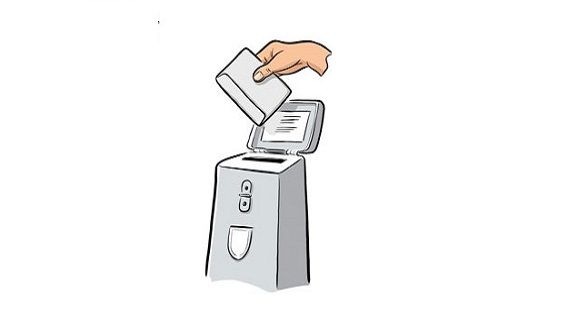
Nota bene:
Open the envelope without damaging it (use the strip along the dotted line on the back of the envelope), since you will need this envelope to send in your ballot paper if you decide to vote by post (check the voting instructions sent by your commune);
If your canton offers online voting and you would like to vote using the online voting system, follow the instructions sent to you by post.

The (red) explanatory brochure from the Federal Council
The envelope to use if voting by post (generally the same envelope that the voting papers arrive in).
The ballot paper
In most cantons, the voting papers also include:
Your polling card or voter identification card
A ballot envelope
Nota bene:
The colour and size of the polling card, ballot envelope and the return envelope if voting by post may vary depending on the canton or commune.
If you do not receive the official voting papers, if some of the voting papers are missing, or if you wish to receive the voting paper in another language (federal votes), please contact your commune of residence; if you live abroad, contact the commune where you last lived or if you have not lived in Switzerland, your commune of origin.
If a cantonal or communal election or vote is held in your canton on the same day as a federal vote, the voting papers will also include the ballot papers and explanatory information for these elections or votes.

Read the brochure from the Federal Council, visit the official websites (admin.ch, parlament.ch, ch.ch) and watch the Federal Council’s YouTube channel.
Other sources of information include websites of political parties, initiative committees and referendum committees; newspapers; and political broadcasts on radio and television.

When you are ready to answer the questions on the ballot paper, use a pen to complete the ballot paper.
Nota bene:
Use only the official voting papers sent by your commune;
Use a pen, and not a pencil;
In most cantons, you cast your vote by writing YES or NO or their Swiss-language equivalents on the right-hand-side next to the questions; it is advisable to respond in the Swiss language used locally. In the cantons and communes that provide automatic readers, you simply need to check the box next to YES or NO;
If you do not want to answer a question, leave the space provided blank; your ballot will not be void, but counted as blank;
Do not add any comments, drawings or signs to your response; do not scribble on the envelopes or on the polling card; if you make a mistake on your polling paper, do not correct it with Tipp-Ex, etc.: contact your commune instead.

If you go to the polling station, place your ballot paper in the ballot envelope and seal the envelope, and take along an ID and your polling card.
After checking your ID, the polling official will handle your ballot.
Nota bene:
Be sure to use only official voting papers. If your voting papers are lost or damaged, contact your commune.
The ballot envelope is personal: use it only for your ballot paper.

If you vote by post, place the ballot envelopes with the ballots in the main envelope, following the instructions from your commune.
Nota bene:
You need to sign the polling card by hand. Some cantons also require your date of birth. Check the voting instructions for your canton.
The main envelope must only contain your ballot envelope and your polling card . No other documents may be placed in this envelope.

You can generally seal the main envelope using the adhesive strip. Check your canton’s instructions.
Nota bene: If you ripped the main envelope when opening it or if you lose the envelope, contact your commune ASAP for a replacement.

Depending the canton or commune, you may need to put a stamp on the main envelope. Pay attention to shipping time (A or B post).
Nota bene: If you mail your ballot from within Switzerland, it is recommended to mail it by the Tuesday (B post) or the Thursday (A post) before the vote. Information on this from the canton is usually included with the voting papers. Swiss people living abroad should mail their envelopes as soon as possible.

